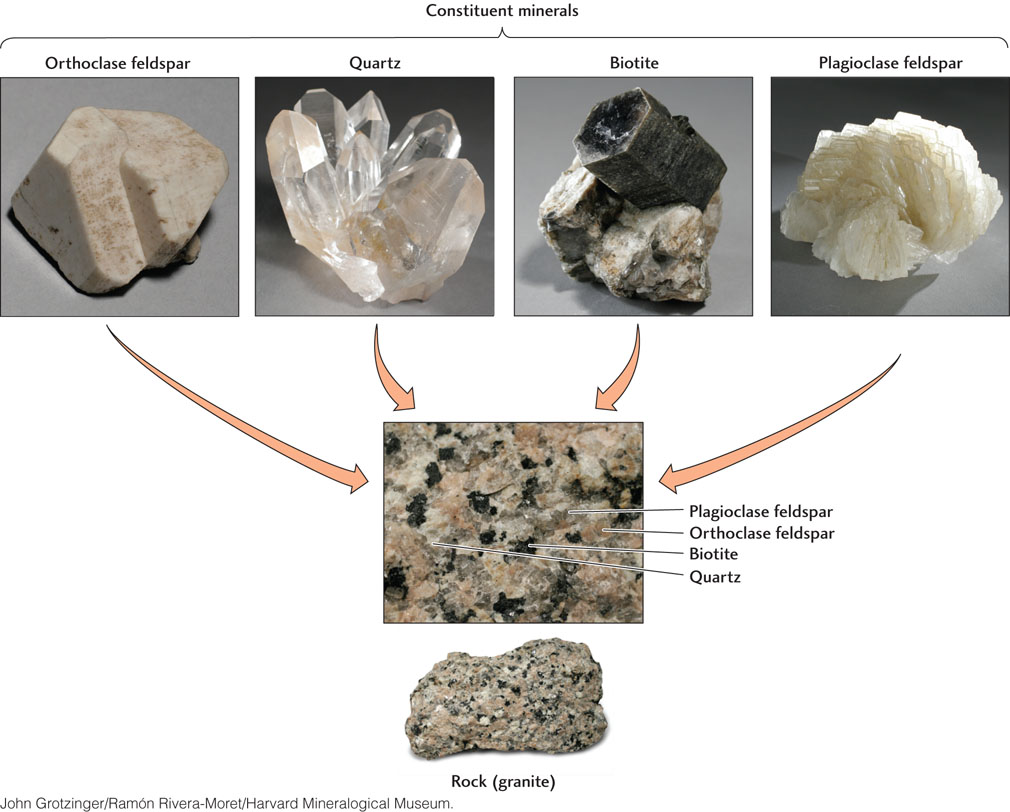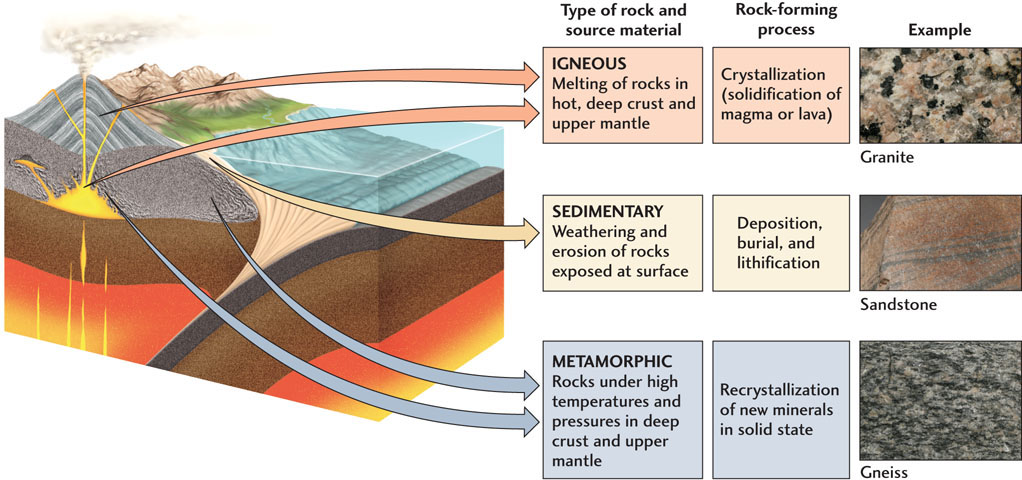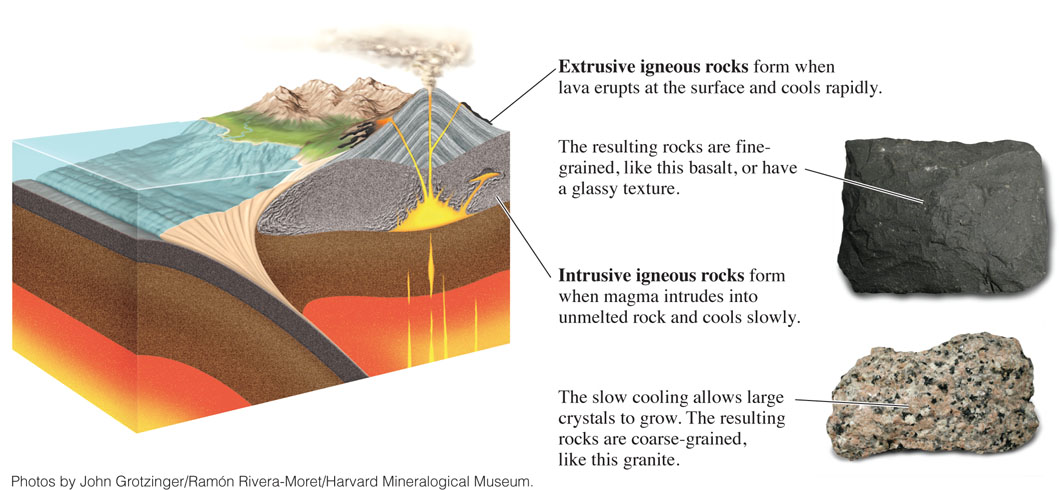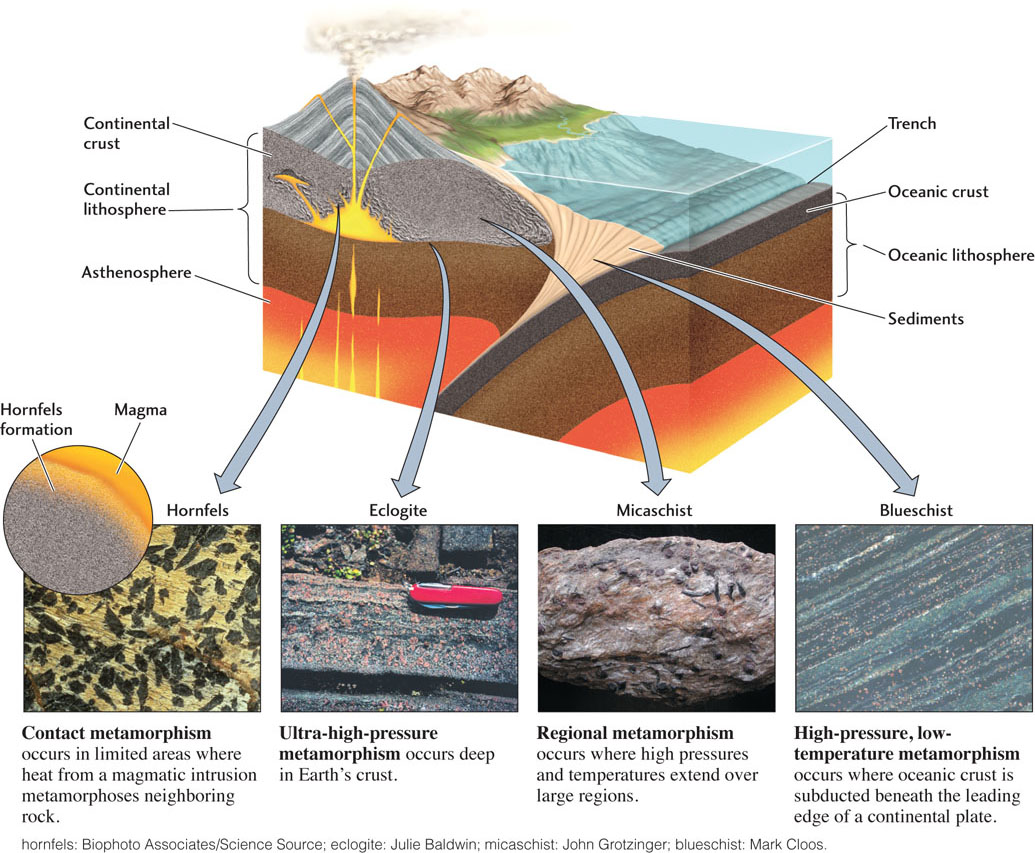What Are Rocks?
A geologist’s primary aim is to understand the properties of rocks and to deduce their geologic origins from those properties. Such deductions further our understanding of our planet, and they also provide important information about economically important resources. For example, knowing that oil forms in certain kinds of sedimentary rocks that are rich in organic matter allows us to explore for oil reserves more intelligently. Understanding how rocks form also guides us in solving environmental problems. For example, the underground storage of radioactive and other wastes depends on analysis of the rock to be used as a repository: Will this rock be prone to earthquake-triggered landslides? How might it transmit polluted waters in the ground?
Properties of Rocks
A rock is a naturally occurring solid aggregate of minerals or, in some cases, nonmineral solid matter. In an aggregate, minerals are joined in such a way that they retain their individual identity (Figure 3.23). A few rocks are composed of nonmineral matter. These rocks include the noncrystalline, glassy volcanic rocks obsidian and pumice as well as coal, which is made up of compacted plant remains.

What determines the physical appearance of a rock? Rocks vary in color, in the sizes of their crystals or grains, and in the kinds of minerals that compose them. Along a road cut, for example, we might find a rough white and pink speckled rock composed of interlocking crystals large enough to be seen with the naked eye. Nearby, we might see a grayish rock containing many large, glittering crystals of mica and some grains of quartz and feldspar. Overlying both the white and pink rock and the gray one, we might see horizontal layers of a striped white and mauve rock that appear to be made up of sand grains cemented together. And these rocks might all be overlain by a dark, fine-grained rock with tiny white dots in it.
The identity of a rock is determined partly by its mineralogy and partly by its texture. Here, the term mineralogy refers to the relative proportions of a rock’s constituent minerals. Texture describes the sizes and shapes of a rock’s mineral crystals or grains and the way they are put together. If the crystals or grains, which are only a few millimeters in diameter in most rocks, are large enough to be seen with the naked eye, the rock is categorized as coarse-grained. If they are not large enough to be seen, the rock is categorized as fine-grained. The mineralogy and texture that determine a rock’s appearance are themselves determined by the rock’s geologic origin—where and how it formed (Figure 3.24).

The dark rock that caps the sequence of rocks in our road cut, called basalt, was formed by a volcanic eruption. Its mineralogy and texture were determined by the chemical composition of rocks that were melted deep within Earth. All rocks formed by the solidification of molten rock, such as basalt and granite, are called igneous rocks.
The striped white and mauve layers in the road cut are sandstone, formed as sand particles accumulated, perhaps on an ancient beach, and eventually were covered over, buried, and cemented together. All rocks formed as the burial products of layers of sediments (such as sand, mud, or the calcium carbonate shells of marine organisms), whether they were laid down on land or under the sea, are called sedimentary rocks.
The grayish rock of our road cut, a gneiss, contains crystals of mica, quartz, and feldspar. It formed deep in Earth’s crust as high temperatures and pressures transformed the mineralogy and texture of buried sedimentary rock. All rocks formed by the transformation of preexisting solid rock under the influence of high temperatures and pressures are called metamorphic rocks.
75
76
The three types of rocks seen in our road cut represent the three great families of rock: igneous, sedimentary, and metamorphic. Let’s take a closer look at each of these families and at the geologic processes that form them.
Igneous Rocks
Igneous rocks (from the Latin ignis, meaning “fire”) form by crystallization from magma. When a body of magma cools slowly in Earth’s interior, the minerals it contains begin to form microscopic crystals. As the magma cools below its melting point, some of these crystals have time to grow to several millimeters in diameter or larger before the whole mass crystallizes as a coarse-grained igneous rock. But when magma erupts from a volcano onto Earth’s surface as lava, it cools and solidifies so rapidly that individual crystals have no time to grow gradually. In that case, many tiny crystals form simultaneously, and the result is a fine-grained igneous rock. Geologists distinguish two major types of igneous rocks—intrusive and extrusive—on the basis of the sizes of their crystals.
Intrusive and Extrusive Igneous Rocks
Intrusive igneous rocks crystallize when magma intrudes into unmelted rock masses deep in Earth’s crust. Large crystals grow as the magma slowly cools, producing coarse-grained rocks. Intrusive igneous rocks can be recognized by their large, interlocking crystals (Figure 3.25). Granite is an intrusive igneous rock.

Extrusive igneous rocks form from magmas that erupt at Earth’s surface as lava and cool rapidly. Extrusive igneous rocks, such as basalt, are easily recognized by their glassy or fine-grained texture.
Common Minerals of Igneous Rocks
Most of the minerals of igneous rocks are silicates, partly because silicon is so abundant in Earth’s crust and partly because many silicate minerals melt at the high temperatures and pressures reached in deeper parts of the crust and in the mantle. The silicate minerals most commonly found in igneous rocks include quartz, feldspars, micas, pyroxenes, amphiboles, and olivines (Table 3.5).
| Igneous Rocks | Sedimentary Rocks | Metamorphic Rocks |
|---|---|---|
| Quartz | Quartz | Quartz |
| Feldspar | Clay minerals | Feldspar |
| Mica | Feldspar | Mica |
| Pyroxene | *Calcite | Garnet |
| Amphibole | *Dolomite | Pyroxene |
| Olivine | *Gypsum | Staurolite |
| *Halite | Kyanite | |
| *Nonsilicate minerals. |
77
Sedimentary Rocks
Sediments, the precursors of sedimentary rocks, are found at Earth’s surface as layers of loose particles, such as sand, silt, and the shells of organisms. These particles originate in the processes of weathering and erosion. Weathering refers to all of the chemical and physical processes that break up and decay rocks into fragments and dissolved substances of various sizes. These particles are then transported by erosion, the set of processes that loosen soil and rock and move them downhill or downstream to the spot where they are deposited as layers of sediment (Figure 3.26).

Sediments are deposited in two ways:
 Siliciclastic sediments are made up of physically deposited particles, such as grains of quartz and feldspar derived from weathered granite. (Clastic is derived from the Greek word klastos, meaning “broken.”) These sediments are laid down by running water, wind, and ice.
Siliciclastic sediments are made up of physically deposited particles, such as grains of quartz and feldspar derived from weathered granite. (Clastic is derived from the Greek word klastos, meaning “broken.”) These sediments are laid down by running water, wind, and ice. Chemical sediments and biological sediments are new chemical substances that form by precipitation. Weathering dissolves some of a rock’s components, which are carried in stream waters to the ocean. Halite is a chemical sediment that precipitates directly from evaporating seawater. Calcite is precipitated by marine organisms to form shells or skeletons, which form biological sediments when the organisms die.
Chemical sediments and biological sediments are new chemical substances that form by precipitation. Weathering dissolves some of a rock’s components, which are carried in stream waters to the ocean. Halite is a chemical sediment that precipitates directly from evaporating seawater. Calcite is precipitated by marine organisms to form shells or skeletons, which form biological sediments when the organisms die.
From Sediment to Solid Rock
Lithification is the process that converts sediments into solid rock. It occurs in two ways:
 In compaction, particles are squeezed together by the weight of overlying sediments into a mass denser than the original.
In compaction, particles are squeezed together by the weight of overlying sediments into a mass denser than the original. In cementation, minerals precipitate around deposited particles and bind them together.
In cementation, minerals precipitate around deposited particles and bind them together.
Sediments are compacted and cemented after they are buried under additional layers of sediments. Sandstone forms by the lithification of sand particles, and limestone forms by the lithification of shells and other particles of calcite.
Layers of Sediment
Sediments and sedimentary rocks are characterized by bedding, the formation of parallel layers of sediment as particles are deposited. Because sedimentary rocks are formed by surface processes, they cover much of Earth’s land surface and seafloor. In terms of surface area, most rocks found at Earth’s surface are sedimentary, but these rocks weather easily, so their volume is small compared with that of the igneous and metamorphic rocks that make up the main volume of the crust.
78
Common Minerals of Sedimentary Rocks
The most common minerals in siliciclastic sediments are silicates because silicate minerals predominate in the rocks that weather to form sedimentary particles (see Table 3.5). The most abundant silicate minerals in siliciclastic sedimentary rocks are quartz, feldspar, and clay minerals. Clay minerals are formed by the weathering and alteration of preexisting silicate minerals, such as feldspar.
The most abundant minerals of chemical and biological sediments are carbonates, such as calcite, the main constituent of limestone. Dolomite is a calcium-magnesium carbonate formed by precipitation during lithification. Two other chemical sediments—gypsum and halite—form by precipitation as seawater evaporates.
Metamorphic Rocks
Metamorphic rocks take their name from the Greek words for “change” (meta) and “form” (morphe). These rocks are produced when high temperatures and pressures deep within Earth cause changes in the mineralogy, texture, or chemical composition of any kind of preexisting rock—igneous, sedimentary, or other metamorphic rock—while maintaining its solid form. The temperatures of metamorphism are below the melting point of the rocks (about 700°C), but high enough (above 250°C) for the rocks to be changed by recrystallization and chemical reactions.
Regional and Contact Metamorphism
Metamorphism may take place over a widespread area or a limited one (Figure 3.27). Regional metamorphism occurs where high pressures and temperatures extend over large regions, as happens where plates collide. Regional metamorphism accompanies plate collisions that result in mountain building and the folding and breaking of sedimentary layers that were once horizontal. Where high temperatures are restricted to smaller areas, as in the rocks near and in contact with a magmatic intrusion, rocks are transformed by contact metamorphism. Other types of metamorphism, which we will describe in Chapter 6, include high-pressure metamorphism and ultra-high-pressure metamorphism.

79
Many regionally metamorphosed rocks, such as schists, have characteristic foliation, wavy or flat planes produced when the rock was folded. Granular textures are more typical of most contact metamorphic rocks and of some regional metamorphic rocks formed by very high pressures and temperatures.
Common Minerals of Metamorphic Rocks
Silicates are the most abundant minerals in metamorphic rocks because most of the parent rocks from which they are formed are rich in silicates (see Table 3.5). Typical minerals of metamorphic rocks are quartz, feldspars, micas, pyroxenes, and amphiboles—the same kinds of silicates characteristic of igneous rocks. Several other silicates—kyanite, staurolite, and some varieties of garnet—are characteristic of metamorphic rocks alone. These minerals form under conditions of high pressure and temperature in the crust and are not characteristic of igneous rocks. They are therefore good indicators of metamorphism. Calcite is the main mineral of marbles, which are metamorphosed limestones.